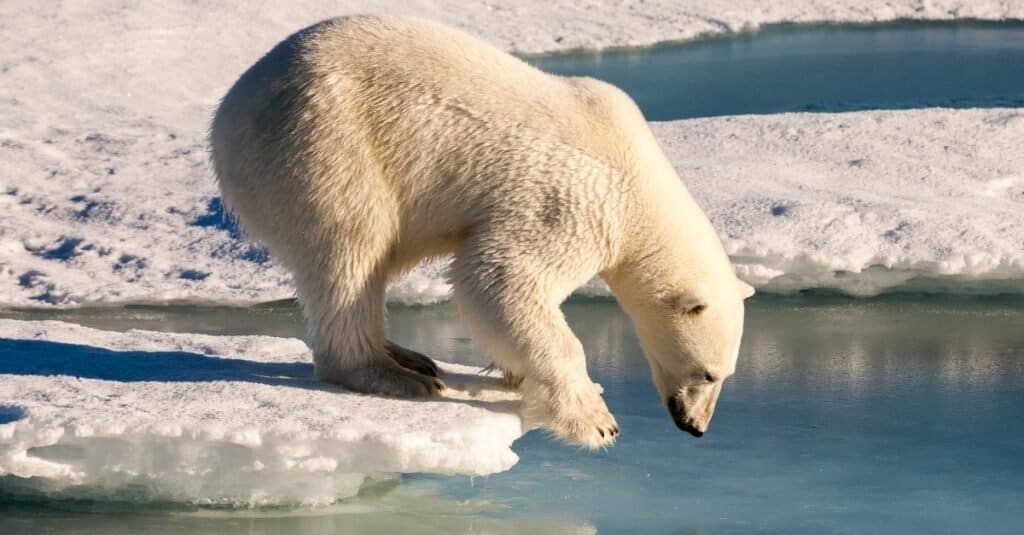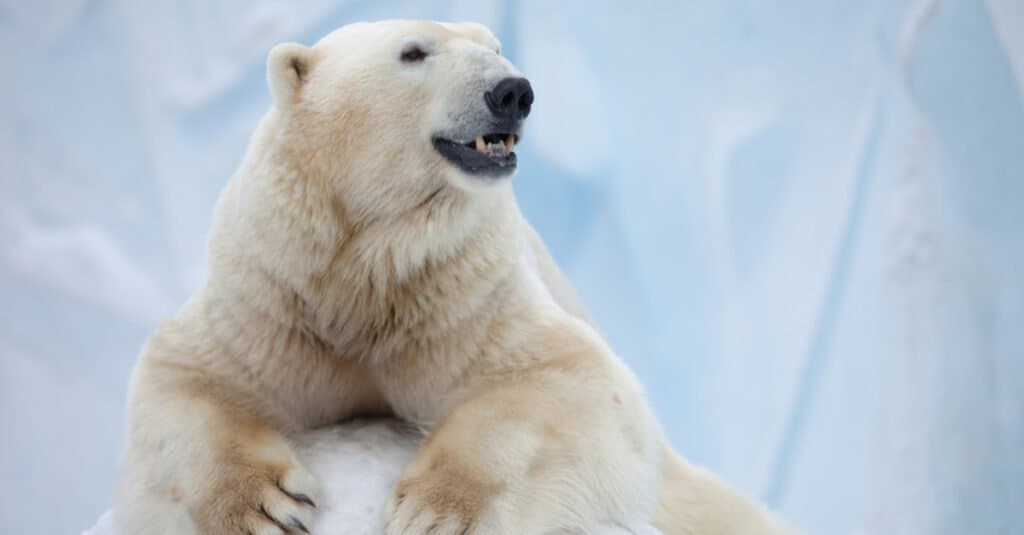Coated in a beautiful white coat, polar bears are one of the strongest animals on earth. Living in the Arctic, they are extremely large and tower over any other bear species in the world. There are many interesting facts to know about polar bears, like how they can survive freezing temperatures as low as -50° Fahrenheit. Polar bears are giant and have a powerful bite force to match their size, but exactly how strong is their bite?
In this article, you will learn about the strength of a polar bear and its mighty bite. The Arctic is a unique habitat filled with animals suited to survive the freezing cold. Foxes, arctic hares, walrus, and even the majestic narwhal live in the arctic. Still, polar bears are the top apex predator in their habitat. Let’s learn how strong a polar bear’s bite is and other amazing facts about this animal.
What Is The Bite Force Of The Polar Bear?

Polar bears can swim for long distances and steadily for many hours to get from one piece of ice to another.
©Vladimir Gjorgiev/Shutterstock.com
Polar bears have a powerful bite force of 1200 psi, the strongest amongst all bear species. Their large size contributes to how strong they can bite and what makes them the most deadly bear in the world.
The largest polar bear ever recorded weighed more than 2,000 pounds and had a height of around 11 feet. On average, the males weigh between 700 to 1500 pounds, while females are much smaller, only weighing between 330 to 650 pounds. Polar bears are around 5.9 to 10 ft tall, towering over other bear species. Being so large, they can survive Arctic temperatures and successfully hunt the various animals found in their habitat.
Polar bears are the largest modern land predator and are so large because of their habitat. Their size helps them stay warm and not die in below-freezing temperatures. Polar bears, like other mammals, follow Bergmann’s rules. This rule says that the colder the temperature, the larger the mammal. This rule is valid for many bird and mammal species, but it is not the case for some. Colder areas have the largest polar bears, which also have a great bite force.
What Do Polar Bears Eat?

Beautiful polar bear standing on the edge of an ice floe, looking at his mirror image in the sea.
©Mario_Hoppmann/Shutterstock.com
Polar bears are primarily carnivores and are the most dominant predator in the arctic. They eat a diet that consists mostly of seals, but will also feed on other animals like narwhals, reindeer, and fish.
Their powerful bite force and 42 sharp teeth make them excellent hunters. Compared with other bears like the brown bear or black bear, polar bears are the most carnivorous species. While other bears live in habitats with fruits, berries, grass, and other plant life, polar bears only have access to the arctic food sources. Plants make up a small amount of their diets, but polar bears will only eat these on rare occasions. In summer and periods of food shortages, polar bears are more likely to eat plants.
Some things a polar bear will eat:
Seals are the polar bear’s favorite food, but this food source is not always readily available. They prefer to eat meat and hunt any animal they come across if hungry. The polar bear’s strong bite and sharp teeth help it eat its prey and bite through thick flesh. If meat is not available, they will eat kelp, plants, and sometimes garbage left behind by humans. Polar bears also have a strong sense of smell that helps them track dead animals from up to 20 miles away.
Polar bears have incisors, canines, and molars designed to help them eat their prey. Canine teeth are good for grasping prey and ripping through thick hides. Their incisors are like knives, helpful in tearing into flesh. Like humans, polar bears also have molars which they use to chew. The polar bear’s teeth, bite force, and size makes it the king of the artic and is helpful for taking down a variety of prey.
Are Polar Bears Dangerous?

The coat of a polar bear helps it blend into the snowy habitat.
©Zhiltsov Alexandr/Shutterstock.com
Polar bears are aggressive and one of the most deadly bears. They may have a cute and fluffy look, but this species should not be underestimated. Needing to eat such a large amount, it is not unreasonable for a polar bear to see a human as food. They are strong and speedy, capable of running up to 25 mph.
Even with their large size and dangerous features, polar bears are usually not as dangerous as other bears. Since polar bears live in the arctic, attacks on humans are rare, but still happen. Coming across one is nearly impossible unless you work in the arctic or live in an area near their habitat. Grizzly bear attacks are much more common since they inhabit areas where humans are more likely to be, but still, they are really rare. Brown bears live all over North America and are just as dangerous as the polar bear.
Are Polar Bears Becoming Endangered?

Polar Bear mother with cubs
©Steve Amstrup, Public domain, via Wikimedia Commons – License
Polar bears are not endangered but have been slowly losing their population. They are listed as a threatened species and will continue to decline if the threats they face are not resolved. Climate change and habitat loss are one of the main reasons polar bears are declining in numbers. Polar bears are just one of many animals affected by climate change. They will continue to see a significant loss in population if the earth continues to warm.
The Arctic is the primary habitat that polar bears live in. All 19 subpopulations of polar bears have been affected by the melting of the ice in their habitat. Since they need to eat so much, they will have fewer resources to feed on as other animals of the artic will also be affected by climate change. Around 22,000 to 31,000 polar bears are alive today and are they are the kings of their habitat.
The photo featured at the top of this post is © Zhiltsov Alexandr/Shutterstock.com
Thank you for reading! Have some feedback for us? Contact the AZ Animals editorial team.






